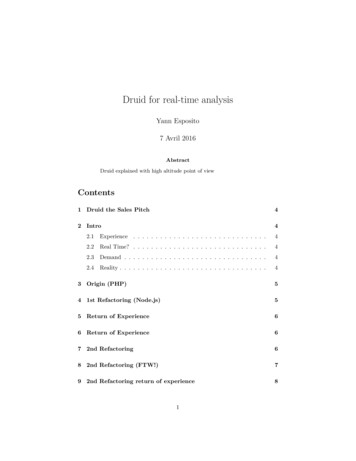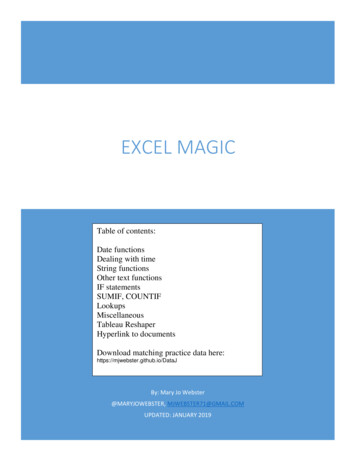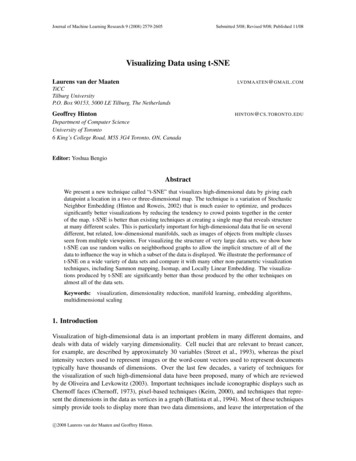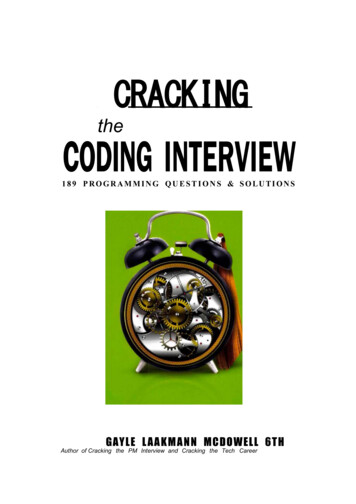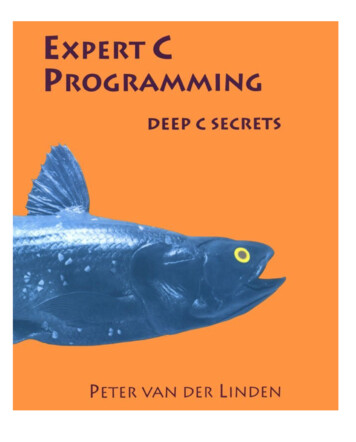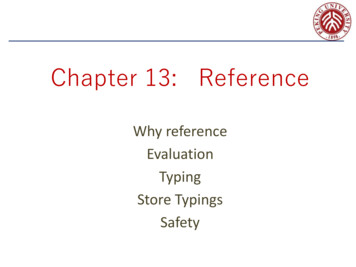
Transcription
101PerformanceEvaluationTestsBrian Mackenzie
i Electric Word plc 2005All rights reserved. No part of this publication may bereproduced, stored in a retrieval system, or transmitted, in anyform or by any means, electronic, mechanical, photocopying,recording or otherwise without the permission of the publishers.The information contained in this publication is believed to becorrect at the time of manufacture. Whilst care has been taken toensure that the information is accurate, the publisher can acceptno responsibility for any errors or omissions or for changes todetails given.Any application of the information provided in this workbookis at the athlete’s own discretion and risk.A CIP catalogue record for this book is available from theBritish Library.Publisher:Jonathan Pyejonathan.pye@electricwordplc.comEditor:Brian Mackenziebrian@brianmac.demon.co.ukDesigner:The Flying Fish Studios Ltdwww.the-flying-fish.comPublished by:Electric Word plc67-71 Goswell RoadLondon EC1V 7EPTel: 0845 450 6402Registered number: 3934419ISBN: 1-905096-18-6
31333537394144474951522Endurance1.1 Astrand Treadmill Test1.2 Balke Treadmill Test1.3 Balke VO2max Test1.4 Bruce Treadmill Test1.5 The 2.4 kilometre Run Test1.6 Conconi Test1.7 Cooper VO2max Test1.8 Critical Swim Speed1.9 Harvard Step Test1.10 Astrand Cycle Test1.11 Home Step Test1.12 Three Minute Step Test1.13 Multi-Stage Fitness Test1.14 Queen’s College Step Test1.15 Rockport Fitness Walking Test1.16 Tecumseh Step Test1.17 Treadmill VO2max Test1.18 VO2max from a One Mile Jog1.19 VO2max from Non-exercise Data1.20 Running-based Anaerobic Sprint Test (RAST)1.21 Tri-level Aerobic Test1.22 Tri-level Lactic Power Test1.23 Tri-level Alactic Power Test1.24 Cunningham and Faulkner TestAgility2.1 Hexagonal Obstacle Test2.2 Zig-Zag Test2.3 505 Agility Test2.4 Illinois Agility Run Test2.5 Lateral Change of Direction Test2.6 Quick Feet Test55575960626466
iv2.72.8345Burpee Test‘T’Drill testMobility and Balance3.1 Modified Sit & Reach Test3.2 Sit and Reach Test3.3 Hip Flexion Test3.4 Static Flexibility Test – Ankle3.5 Static Flexibility Test – Hip and Trunk3.6 Static Flexibility Test – Shoulder3.7 Static Flexibility Test – Shoulder & Wrist3.8 Static Flexibility Test – Trunk and Neck3.9 Trunk Flexion Test3.10 Standing Stork Test3.11 Standing Stork Test – BlindBody Composition4.1 Body Mass index4.2 Body Fat Percentage4.3 Jackson and Pollock Skinfold Test4.4 Yuhasz Skinfold TestStrength5.1 Core Muscle Strength and Stability Test5.2 Curl Up Test5.3 Canadian Crunch Test5.4 Sit Ups Test5.5 Jumps Decathlon5.6 Leg Strength Test5.7 Standing Long Jump Test5.8 Sprint Bound Index Test5.9 Sergeant Jump Test5.10 Chin Up Test5.11 Grip Strength Test5.12 Medicine Ball Javelin Quadrathlon5.13 Press-ups Test5.14 Bench Press Test5.15 Universal Bench Press Test5.16 Metronome Bench Press Test5.17 Overhead Press Test5.18 Leg Press Test5.19 Leg Curl Test5.20 Dynamic Knee Extension 8150152
v5.215.225.235.245.255.265.275.286Biceps Curl TestSquats TestHandgrip Strength TestFlexed Arm-Hang TestWall Squat TestThe McCloy Physical Fitness TestThe QuadrathlonThe Wilf Paish Rugby Football TestsSpeed and Power6.1 10 Stride Test6.2 30 metre Acceleration Test6.3 60 metre Speed Test6.4 Shuttle Run Test6.5 150 metre Endurance Test6.6 250 metre Endurance Test6.7 400 metre Sprint Test6.8 300 yard Shuttle Test6.9 400 metre Drop Off Test6.10 Margaria-Kalamen Power Test6.11 400 metre Control Tests6.12 40 metre Sprint Test6.13 30 metre Sprint Fatigue – Power Maintenance Test6.14 Concept 2 Rowing Step Test6.15 Flying 30 metre Test6.16 Kosmin Test6.17 The LAS (Lactic vs. Speed) Test6.18 PWC-170 Cycle Test6.19 The Wingate Anaerobic 30 cycle Test6.20 35 metre Speed Test6.21 Multiple Sprint s Psychology7.1 Sport Competition Anxiety Test (SCAT)7.2 TEOSQ – Task and Ego Orientation in Sport Questionnaire2132142168General Health8.1 Orthostatic Heart Rate Test8.2 Urine Colour Measurement8.3 Waist to Hip Ratio Evaluation Test219220222224Appendix A – VO2max Tables226
viiIntroductionThe success of a training program is largely dependent upon satisfying theperformance aims associated with it and evaluation (testing and measuring) isthe means of collecting information upon which subsequent performanceevaluations and decisions can be made.In constructing a test it is important to make sure that it really measure thefactors required to be tested, and is thus objective rather than subjective. Indoing so all tests should therefore be specific (designed to assess an athlete'sfitness for the activity in question), valid (test what they purpose to test),reliable (capable of consistent repetition) and objective (produce a consistentresult irrespective of the tester).Evaluation tests can be broken down into two main types: Maximal tests,where the athlete works at maximum effort or tested to exhaustion, and SubMaximal tests, where the athlete works below maximum effort andextrapolation is used to estimate maximum capacity.The results from an evaluation test can be used to:4 predict future performance4 indicate weaknesses4 measure improvement4 enable the coach to assess the success of the training program4 place the athlete in appropriate training group4 motivate the athlete.It is important to bear in mind that there are many factors that can influencethe outcome of an evaluation test – they include:4 the ambient temperature, noise level and humidity4 the amount of sleep the athlete had prior to testing4 the athlete's emotional state4 medication the athlete may be taking4 the time of day4 the time since the athlete's last meal4 the test environment – surface (track, grass, road, gym)4 the athlete's prior test knowledge/experience
viii44444accuracy of measurements (times, distances etc)is the athlete actually applying maximum effort in maximal testsinappropriate warm uppeople presentthe personality, knowledge and skill of the tester.As a coach I regularly test my athletes to ensure that their training program isachieving the performance objectives. On the following pages you will find aselection of evaluation tests for endurance, agility, mobility & balance, bodycomposition, strength, speed & power and sports psychology that I havegathered and developed over the years and which I hope you will find beneficialin monitoring your athlete’s or your athletic development.Please let me know how you get on!Best wishesBrian MackenzieEditorbrian@brianmac.demon.co.uk
11EnduranceFitness can be measured by the volume of oxygen you can consume whileexercising at your maximum capacity. VO2max is the maximum amount ofoxygen in millilitres, one can use in one minute per kilogram of body weight.Those who are fit have higher VO2max values and can exercise more intenselythan those who are not as well conditioned. Numerous studies show that youcan increase your VO2max by working out at an intensity that raises your heartrate to between 65 and 85% of its maximum for at least 20 minutes three tofive times a week. A mean value of VO2max for male athletes is approx. 3.5litres/minute and for female athletes it is about 2.7 litres/minute.Aerobic enduranceAerobic fitness is primary for most sports. Trainers must think carefully aboutthe fitness level they believe is appropriate for peak performance and thenachieve that. For example, in elite football a high aerobic capacity is important,but for volleyball, a moderate level will suffice. For most games, aerobic fitnessgoverns how quickly one recovers between high intensity sections, and howmuch distance can be covered in a game.Anaerobic enduranceDuring anaerobic (without oxygen) work, involving maximum effort, the bodyis working so hard that the demands for oxygen and fuel exceed the rate ofsupply and the muscles have to rely on the stored reserves of fuel. In thissituation waste products accumulate, the chief one being lactic acid. Themuscles, being starved of oxygen, take the body into a state known as oxygendebt. The body's stored fuel soon runs out and activity ceases and will not beresumed until the lactic acid is removed and the oxygen debt repaid.Fortunately the body can resume limited activity after even only a smallproportion of the oxygen debt has been repaid.
214ENDURANCEEndurance evaluation testsThe following are examples of aerobic endurance tests:4 Astrand treadmill test4 Balke treadmill test4 Balke VO2max test4 Bruce treadmill test4 The 2.4km run test4 Conconi test4 Cooper VO2max test4 Critical swim speed4 Harvard step test4 Astrand cycle test4 Home step test4 Three minute step test4 Multistage fitness test4 Queens college step test4 Rockport fitness walking test4 Tecumseh step test4 Treadmill VO2max test4 VO2max from a one mile jog4 VO2max from non-exercise data4 Running based anaerobic sprint test (RAST)4 Tri-level aerobic test4 Tri-level lactic power test4 Tri-level Alactic Power Test4 Cunningham and Faulkner test
11.144ENDURANCEAstrand Treadmill TestThe objective of this test is to monitor the development of the athlete'sgeneral endurance (VO2max).Required resourcesTo undertake this test you will require:4 Treadmill where the speed can be set at 5 mph (8.05 km/hr) and grade ofslope can be adjusted4 Stop watch4 Assistant.How to conduct the test4 The treadmill is set up at the start with a speed of 8.05km/hr (5 mph) anda grade of slope of 0%4 The athlete commences the test4 After 3 minutes the grade is set to 2.5% and then every 2 minutes thegrade is increased by 2.5%4 The assistant starts the stop watch at the start of the test and stops itwhen the athlete is unable to continue.AnalysisAnalysis of the result is by comparing it with the results of previous tests. It isexpected that, with appropriate training between each test, the analysis wouldindicate an improvement.From the total running time an estimate of the athlete's VO2max can becalculated as follows:4 VO2max (Time x 1.444) 14.994 “Time” is the total time of the test expressed in minutes and fractions ofa minute.Example:The athlete stopped the test after 13 minutes 15 seconds of running (13.25minutes).4 VO2max (13.25 x 1.444) 14.994 VO2max 34.123 mls/kg/min.3
414ENDURANCETarget groupThis test is suitable for endurance athletes and players of endurance sports(eg football, rugby) but not for individuals where the test would becontraindicated.ReliabilityReliability would depend upon how strict the test is conducted and theindividual's level of motivation to perform the test.ValidityThere are published VO2max tables (Appendix A) and the correlation to actualVO2max is high.On-line calculatorSelect the following link to access the on-line calculator4 astrand treadmill test.htm
11.244ENDURANCEBalke Treadmill TestThe objective of this test is to monitor the development of the athlete'sgeneral endurance (VO2max).Required resourcesTo undertake this test you will require:4 Treadmill where speed and grade of slope can be adjusted4 Stop watch4 Assistant.How to conduct the testThe athlete walks on a treadmill to exhaustion. At timed stages during the testthe grade of slope (%) of the treadmill is increased as follows:4 Active and sedentary men1 Treadmill speed set at 3.3 mph (5.3km/hr)1 Start – Grade is 0%1 After 1 minute – Grade set at 2%1 After 2 minutes and each minute thereafter the grade is increased by 1%4 Active and sedentary women1 Treadmill speed set at 3.0 mph (4.5 km/hr)1 Start – Grade is 0%1 After 3 minutes and every 3 minutes thereafter the grade is increasedby 2.5%4 The assistant starts the stop watch at the start of the test and stops itwhen the athlete is unable to continue – this ideally should be between9 and 15 minutes.AnalysisAnalysis of the result is by comparing it with the results of previous tests. It isexpected that, with appropriate training between each test, the analysis wouldindicate an improvement.Active and sedentary men – Pollock et al. 1976From the total time an estimate of the athlete's VO2max can be calculated asfollows:4 VO2max 1.444 x T 14.994 “T” is the total time of the test expressed in minutes and fractions of aminute eg 13 minutes, 15 seconds 13.25 minutes.5
614ENDURANCEActive and sedentary women – Pollock et al. 1982From the total time an estimate of the athlete's VO2max can be calculated asfollows:4 VO2max 1.38 x T 5.224 “T” is the total time of the test expressed in minutes and fractions ofa minute.Target groupThis test is suitable for active and sedentary individuals but not for thosewhere the test would be contraindicated.ReliabilityReliability would depend upon how strict the test is conducted and theindividual's level of motivation to perform the test.ValidityThere are published VO2max tables (Appendix A) and the correlation to actualVO2max is high.On-line calculatorSelect the following link to access the on-line calculator4 balke treadmill test.htm
11.344ENDURANCEBalke VO2max TestThe objective of this test is to monitor the development of the athlete'sgeneral endurance (VO2max).Required resourcesTo undertake this test you will require:4 400m track4 Stop watch4 Assistant.How to conduct the testThe Balke test is conducted as follows:4 Choose a windless day and run around a track for 15 minutes – the aim isto run as far as possible4 The assistant notes the total distance achieved in the 15 minutes to thenearest 25 metres.AnalysisAnalysis of the result is by comparing it with the results of previous tests. It isexpected that, with appropriate training between each test, the analysis wouldindicate an improvement. The distance achieved can also be used to predictthe athlete’s VO2max.Performance assessmentThe formula used to calculate VO2max (Obsession for Running by Frank Horwill)is:4 VO2max (((Total distance covered / 15) – 133
4 An athletes completes 5200 metres in 15 minutes 4 VO2max (((5200/15) – 133) x 0.172) 33.3 4 VO2max 70 mls/kg/min. Target group. This test is suitable for endurance athletes and players of endurance sports (egfootball, rugby) but not for individuals where the test would be contraindicated. 14ENDURANCE7.

